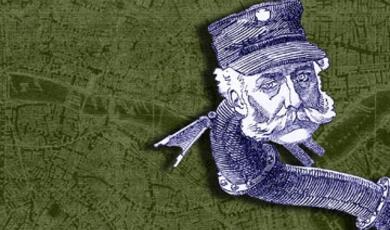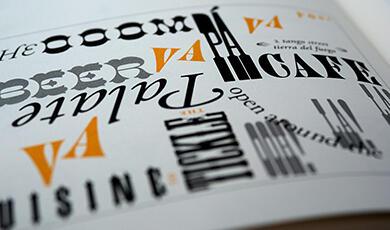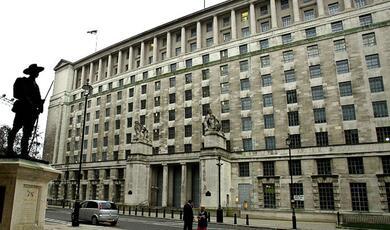20 November 2012
The Survey of London
Professor Andrew Saint
The Survey of London is sometimes described as ‘the official history of London’s buildings’. If that is taken to mean a cumulative source of authority about the history and development of London’s built environment, researched and written by public servants for the public good, those of us who have been lucky enough to work on this great and continuing series would go along with the description. But if ‘official’ is thought to imply a stodgy, old-fashioned or inaccessible style of history, we would strenuously deny the title. In the words of its founder, C. R. Ashbee’s, the Survey’s ultimate aim is ‘to make nobler and more humanly enjoyable the life of the great city’. Today we try and maintain the series’ august traditions, now almost 120 years old, while responding to London’s shifting character and to fresh ideas about how its history should be presented. Our work is very much a living endeavour.
The Survey’s own history is one of remarkable survival, sometimes against the odds. The key to that survival has been its ability to adapt to changing times, methods and institutional affiliations without ever forgetting its chosen task of interpreting the built fabric of London, piece by piece and area by area. Nothing could have been less official than the foundation of the Survey of London. Ashbee, ‘architect, designer and romantic socialist’, to borrow the subtitle of Alan Crawford’s exemplary biography of 1985, had more than a streak of the rebel in his make-up. While serving his architectural apprenticeship in the 1880s, he became one of the young Oxbridge graduates drawn to Toynbee Hall, most successful and enduring of the many missions and settlements set up in late Victorian times to give succour to poorer parts of London and help reconcile the classes. Ashbee’s contribution to this crusade was unusual. As a disciple of Ruskin and Morris, he believed fervently in the moral value of craftsmanship, so he set up a Guild of Handicraft in the East End for local young men and lads, backed by a small practical training school. By 1891 the Guild was established at Essex House, Mile End, and making fine metalwork and cabinetwork. In time elegant silver became the speciality of the Guild. It remains to this day the primary craft of its successors in Chipping Campden, whither Ashbee moved the Guild in 1902, as he deemed the East End too unhealthy, distracting and corrupting for the blend of community and craftsmanship he believed in.
The Guild of Handicraft by no means absorbed all Ashbee’s energies. Like others of his day, he was distressed by the rate of attrition among good older buildings. At that time there was no effective legal mechanism for protecting architecture – a situation that persisted till 1947. Ashbee’s main focus in the 1890s was London and most of all the East End, terra incognita to the average educated Londoner. The destruction of the so-called Old Palace at Bromley by Bow stirred him to action. In 1894 he set up a ‘Watch Committee’ at Essex House, with the idea of compiling a ‘register’ of ‘all work of an artistic and historic interest’ in London. His committee consisted largely of young antiquarians and architectural assistants. Each was assigned an eastern or north-eastern district, running right out to Epping Forest. Ashbee thought it might take them a year to survey and publish the results before moving to other areas of London. The reality was of course different. Everyone, not least Ashbee, was busy with other things, and co-ordination was loose.
Ashbee’s own contribution was, however, decisive. In 1895–6, he waged a successful campaign to preserve the Trinity Hospital, Mile End, a delightful enclave of almshouses built exactly two centuries before, but then and now surrounded by dross. The handsome, hand-printed booklet commemorating that campaign was issued by the Guild and School of Handicraft in 1896 with the portentous title The Trinity Hospital in Mile End: An Object Lesson in National History … being the first monograph of the Committee for the Survey of the Memorials of Greater London. And so the series was launched. This first publication was no mere descriptive history of the almshouses’ fabric. Ashbee called it an ‘object lesson’, because he wanted to demonstrate that the hospital represented part of London’s moral as well as aesthetic heritage. It had been built to house and support elderly sea-captains. The cohesive community life the buildings represented, he argued, was just the kind of good which callous urban development was in danger of destroying. The illustrations reflect this view perfectly. One of the several pull-outs shows a perspective (by Matthew Garbutt) of the hospital surrounded by dismal Victorian housing, and fronted by the outside life of the East End street – an impoverished flower stall, a parked cart, a workman trudging along with his sack on his back, and so forth. Other drawings show the inmates of the almshouses playing chess and drafts, or snoozing in a corner while a dog lifts his leg against the base of a statue, and record commemorative glass panels in the chapel windows. There is just one ‘conventional’ architectural section.
Here then was a strikingly human and outspoken inauguration for the future series. Ashbee, however, was the type of restless, imaginative person who tends not to focus on anything for long. The Watch Committee’s direction soon passed effectively to his solid but less charismatic assistant, Ernest Godman. The series would have probably issued a few monographs and then died, had it not been for Laurence Gomme, statistical officer to the London County Council until 1900, and then Clerk to the Council – in other words the LCC’s highest executive. A cultured individual with fingers in many pies – he was an antiquarian, statistician, urbanist and folklorist – Gomme saw the value of his friend Ashbee’s initiative, and threw the weight of the LCC, then still a fairly new force in London’s life and government, behind its production.
The first ‘parish volume’ of the Survey, on Bromley by Bow, published in 1900 but written well before, was therefore written by Ashbee and his helpers but published by the LCC. It was hardly a true parish volume in the present-day sense. Just fifteen buildings are separately itemized and described in detail, together with four shorter entries. The charming but desultory illustrations lay much emphasis on interior craftwork. The volume was in essence a severely selective inventory, including only buildings, which dated at least in part from before 1700. Still, the series was up and running. In time it would be immensely widened.
Ashbee’s initiative was not without a wider context. For a start, his was not even the first Survey of London. That honour belongs to John Stow, whose famous book of that name, published in 1598, shares with Ashbee’s venture strong human curiosity, a relish for detail, and the regret for past times, supposedly better, that often fuels antiquarian research. Ashbee would have been well aware of Stow and approved his tone. Recording London’s disappearing architecture too goes back some way back into the Victorian period, witness for instance the remarkable Society for Photographing the Relics of Old London, which flourished from 1875 to 1887.
Beyond that, there was accumulating interest in surveying and analysing London, or indeed any great city, as a way first to understanding it and then to proposing solutions for its multifarious problems. Gomme the statistician no doubt looked on the Survey of London as one more tool in the LCC’s armoury for gathering information about the city and thus planning its future, yet with a proper respect for its past. Another enterprise which must have influenced Ashbee was Charles Booth’s Life and Labour of the People in London. That extraordinary social investigation lasted from 1887 to 1902 and spanned seventeen volumes. Like the Survey, Booth’s enterprise was staffed by volunteers and concentrated at first on the much-analysed East End. Its focus was social rather than architectural, as the moral welfare of Londoners, past, present and future, lay at its heart, as it did in Ashbee’s mind. Another figure of some relevance, also a friend of Ashbee’s was Patrick Geddes, the Scottish biologist, sociologist and town-planner. Geddes did not spend much of his career in London. But he was briefly on the Survey of London committee, and his commitment to the practice of urban and regional survey had great influence on the early town planning movement in Britain. Geddes’ mantra was ‘survey before analysis, analysis before plan’.
So the infant Survey of London belonged to a broader movement, national and indeed international, for surveying cities for planning purposes. Indeed the science of modern planning was just starting to find its feet when Ashbee set it going. It is curious that the comparatively modest Survey of London survives, while the greater social enterprises have come and gone, as indeed has the national enthusiasm for planning. Booth’s great work, for instance, was succeeded by the hardly less remarkable New Survey of London Life and Labour (1928–35), undertaken by one of his researchers, Hubert Llewellyn Smith. But this too is forgotten, leaving the Survey of London to plod on alone among the noble but almost insanely ambitious series of investigations into London’s condition inaugurated by late-Victorian idealists.
By the time of the First World War, the early enthusiasts of the Watch Committee with their Ruskinian sense of morality and craftsmanship had largely dropped away in favour of a small band of persistent antiquarians and architects who helped the Survey of London grow to early maturity. These people valued old buildings in a simpler way than Ashbee, but perhaps no less passionately. Among them, Walter Godfrey and Philip Norman were the most active. The LCC was by now not only publishing the volumes, but actually contributing many of the drawings and photographs, while much of the archival work fell to an LCC records officer, W. W. Braines. Gradually the LCC took more and more of the work, until by the 1930s it started to tackle alternating volumes alongside ones written by the London Survey Committee, as the volunteers now called themselves.
This co-operative system proved remarkably productive. The rate of publication of the parish volumes, gradually accepted as the main point of the series, rose from an unevenly spaced five between 1900 and 1914 to almost one a year in the 1930s. Altogether twenty parish volumes had appeared by 1940 and a much more catholic selection of buildings was being made. Volume 20 of 1940, for instance, on the Trafalgar Square area, includes, not only the square, the National Gallery and the Nash development of Carlton House Terrace and its surroundings but even the old County Hall in Spring Gardens, a building of the 1850s inherited by the LCC as its first headquarters. Though much is still left out, the text is on the way to becoming a comprehensive account of the district covered. So it is still of real value to researchers – unlike, for instance, the 1909 and 1913 volumes on Chelsea, which continue to be a bit of an embarrassment to the series because they include so little.
With the LCC’s backing, a handful of regular contributors, growing experience and a tradition of turning out blue-bound volumes of handsome appearance – very generous on space by our standards today – the Survey by the Second World War had a solid reputation and was eating up the ground, at least in central London. Since the LCC’s take-over, it had been accepted that the series would confine itself to the County of London; Greater London was just too much to digest. Even within the LCC area, the Survey avoided the City, with one exception, a volume of 1924 (really a monograph but monographs were sometimes counted as parish volumes) on St Helen’s Church, Bishopsgate. Since then the series has never again ventured into the square mile. That is partly because the LCC and the City of London never saw eye to eye, and partly because tackling the oldest part of the metropolis with its tiny parishes and history of continual rebuildings poses specially difficult challenges. But the simplest reason is that so much else remains to be done.
With its joint authorship model, the inter-war Survey was poised between being official and unofficial. Its subsidised volumes sold respectably to a reading public that had not yet heard of Dr Pevsner, but it was also of use to the LCC as an inventory of older buildings, which it should do its best to protect. Then after the Second World War came two changes. The consequences of the first took time to realise. The 1947 Town and Country Planning Act at last set up a listing system with teeth. The formal designation and inventorisation of worthwhile buildings now became a task performed by national not local government. So the LCC’s use of the Survey for that purpose lost its point. Until the listing system was up and running, the Survey continued on the model of the 1930s, concentrating mainly on the good buildings but placing them in local and historical context. This worked well enough in places like the West End, richly endowed with fine buildings. But the introductory map to Volume 22 of 1950 on Bankside – shockingly, the first parish volume on a south-of-the-river area, and one with a quite different character – shows that the series had not really got beyond the selective approach taken by Ashbee’s committee in Bromley by Bow. The few buildings covered show as the occasional blob of red on a sea of black and white.
The other change came when the Survey Committee finally threw in the towel following the publication in 1952 of Volume 24, the last of four excellent volumes on St Pancras. This was the era of the Welfare State, when voluntary initiative was at a low ebb. The LCC, by contrast, was at the height of its power, planning and rebuilding London. And so the preface to Volume 26 of 1956, on the southern part of Lambeth, the biggest area yet undertaken in a single volume, states proudly that, following the collapse of the Survey committee, ‘the Council therefore decided to complete the Survey alone’.
These changes meant a radical rethink of how the Survey was researched and written, how it presented itself and what it covered. So from 1954 the LCC appointed a new ‘general editor’, Francis Sheppard. Under Sheppard, at the helm from then until 1983, the series subtly and gradually transformed itself. The model he originated, with various further evolutionary and technical changes, is the one which the Survey of London essentially follows today. So Sheppard is the second most important figure in the history of the Survey, after Ashbee.
Francis Sheppard was (and is – he is 90 at the time of writing) the first fully professional historian to work on the Survey. Hitherto it had been a joint enterprise shared between architects, antiquarians and archivists. Sheppard was always interested in the architectural side of things (he had previously worked in what was then the London Museum), but his understanding of London penetrated into its structures and connections – witness his brilliant doctoral thesis on Local Government in St Marylebone, published just before he was appointed to the Survey. He was among a new brand of urban historians who looked well beyond architecture when investigating the structure of a city. He also worked full-time on the Survey, as most of his predecessors had not done. Gradually he was able to gather round him a small team of like-minded researchers and writers who picked up his methods and extended them.
What exactly were these methods? The simplest way to describe them is as holistic. Whereas earlier volumes of the Survey had looked at the buildings in an area one by one and threaded them together only lightly, in the Sheppard volumes the history and character of each area, district or street take priority – not through some vague overview but by meticulously drawing all the data together. The form this new knitting-together took was peculiar to the series, and benefited from fresh ways of writing about cities, notably London. Three influences stand out. One was Steen Eiler Rasmussen’s memorable study of the 1930s, London, The Unique City, which dissected, described and illustrated London’s character in a novel way, and taught readers to admire features like terrace houses and suburban centres which had hitherto been taken for granted or scorned. A second was John Summerson’s Georgian London of 1945, which combined Rasmussen’s techniques of illustration with first-class historical research and superb writing, making it the touchstone for thinking about London’s growth from 1666 onwards for years to come. A third source of influence is perhaps less recognized today. That was the work of H. J. (Jim) Dyos (1921–78), in many respects the pioneer of modern urban history in Britain and a close friend of Francis Sheppard’s. Dyos was interested in the structure of urban communities, particularly in the Victorian period –¬ the transport networks, the pattern of land ownership and development, and the organization of government and services. Most relevant for the Survey was his succinct study of Camberwell, published in 1961 as Victorian Suburb. The book is not really about architecture, but it offers depths of insight about the overall form and appearance of Camberwell as it has come down to us from the nineteenth century.
All these influences, and others, were gradually absorbed by Sheppard and his small team in the 1950s and 60s. In those years the architecture of the West End was under serious threat. So at the LCC’s behest, the Survey spent much of its time in research and publication on parishes like St James, Piccadilly (Volumes 29–32) and St Anne, Soho (Volumes 33 & 34). More adventurous and perhaps even more effective in saving buildings was Volume 27 of 1957 on Spitalfields, another area under severe threat, researched and written largely by Sheppard’s right-hand man of these years, Peter Bezodis. All these books had an authority and coherence lacking in pre-Sheppard volumes. Absolute completeness – the coverage of all standing buildings – was never aimed at, and is still not the aim (the series has always had to be highly selective about buildings that have been demolished, for instance). Nevertheless the sense that a chunk of London has been definitively described and interpreted in volumes that will never lose their utility was established at this time.
Perhaps the high point of the Sheppard years was the early 1970s, after the Survey had been transferred along with other London-wide services from the LCC to the Greater London Council (GLC). The Covent Garden volume (Volume 36 of 1970) came out at a time when that area was threatened by comprehensive redevelopment. The knowledge embodied in the book underpinned the Government’s dramatic decision of 1973 to list over 250 buildings in the area, so leading to a complete reversal of development plans and the GLC’s adoption of a conservation-based approach to regenerating Covent Garden. Here was a classic case of the survey-analysis-policy sequence championed by Geddes. Also in 1973, the Survey published Volume 37, on Northern Kensington. The first of four massive volumes, which over the next thirteen years encompassed the whole of this large, rich and predominantly Victorian parish, Northern Kensington was remarkable in several ways. It was the first to show the full effect of the Dyos revolution, by piecing together the intricate relationship between freeholders, developers and speculative builders, based on exhaustive investigation of the Middlesex Deeds Register – an essential tool for the Survey. If that sounds dry, it was offset by the copious clever and beautiful measured drawings showing plans, elevations and details of Victorian houses, contributed by Frank Evans, John Sambrook and others. If anything let down this book and other volumes of the period, it was the photographic coverage, not always first-rate and clustered together in black-and-white plates at the back. The 1970s marked the height of popularity for the conservation movement; and Northern Kensington sold so well that it almost took the Survey into the mass market. Sales of volumes have never been so high since.
By the time Francis Sheppard retired in 1983, the post-war consensus and the halcyon days for local government were drawing to a close. The writing was soon on the wall for the GLC; so the Survey of London along with the much-respected GLC’s Historic Buildings Division, to which it had long and effectively been allied, had to find new homes. In the event the Survey went in 1986 to the Royal Commission on the Historical Monuments for England (RCHME), while the Historic Buildings Division passed to English Heritage. This split continued until 1999, when the RCHME was amalgamated with English Heritage. Hitherto the Survey, with some five researchers and writers plus supporting staff for the illustrations, had been a very small fish in the big pool of London local government; henceforward it was, rather anomalously, attached to the national structure for conservation policy. The new arrangement had some advantages and some drawbacks. The Survey had been largely left to get on with the job in the Sheppard years. But in the changed atmosphere after 1986 with its constant squeeze on public spending, there was less stability and frequent reorganization, disturbing the series’ productivity.
The new editor, Hermione Hobhouse, rightly felt that the Survey had been concentrating too much on posh areas and needed refreshing. The first volume published under her aegis was a study of County Hall, reviving the Survey’s occasional monograph series and offering a thank-you and farewell for the long, benevolent patronage of the LCC and GLC. The bigger challenge was Poplar, where regeneration was then in full spate under the London Docklands Development Corporation. Research and writing of the two volumes on Poplar, issued in 1994, proved pyrrhic, as the area had been so drastically rebuilt and was in the process of dramatic change before the editors’ eyes. Much that was of interest had already disappeared. But the experience forced the Survey to broaden itself, and to describe and illustrate infrastructure, industrial architecture, public housing and modern buildings with the care hitherto devoted to cosier or more venerable types of architecture. Remarkably, since the Survey volumes were put on line, Poplar rather than West End areas has received the highest number of hits, showing that public interest in London’s history and topography is not dictated by wealth or smartness.
The fresh thinking about how to treat the many areas of London where industry and housing were muddled together, unlike the orderly great estates emphasized by Summerson and to some extent by Sheppard, bore fruit in another long-drawn-out project, on Clerkenwell, finally published in two volumes (46 & 47) in 2008. By then much had changed by way of technique and delivery. Yale University Press had taken over from the Athlone Press as the Survey’s publisher; drawing by computer had succeeded the traditional hand-drawn illustrations; and a higher standard of photography obtained from Poplar onwards, with colour slowly supplanting black and white. All this led to a recasting of the volumes from Clerkenwell onwards along modern publishing lines, with integrated text and pictures. In addition, the series started to become freely available from 2005 via the website British History Online, which carries a number of standard reference works for the historical researcher. This version of the Survey is now much more used than the volumes themselves, and indeed attracts more hits than any other feature of the website except for the Ordnance Survey maps. The one drawback of the online version, which has been created from simple scanning of the Survey volumes, is that the illustrations are not well served, and have occasionally had to be omitted for copyright reasons. The handsome quality of the books, always aesthetically ambitious as well as informative, is lost online.
A question that is now often asked of the Survey, as of other works of reference, is why given the dramatically changed culture of information access and retrieval, the series does not convert to online production and abandon published books. Tradition and conservatism doubtless play a part in the Survey’s adherence to the book. But there are more telling factors as well. Perhaps the most persuasive is that online projects are never fully complete; they must be continually revised and updated, whereas a Survey volume is a stand-alone object, which may date but nevertheless remains prestigious and, in its way, definitive. In the best of all possible worlds the Survey would produce two distinct outputs, a traditional book and a totally different website. But that would require an enlarged staff, hardly foreseeable in present circumstances. Web-based publication and such sidelines as ‘apps’ can also be distracting. It seems better for the time being to press on with as much as possible of the three-fifths of inner London still not covered, and to convert the books into online resources by the simplest method. Another point to bear in mind is that the web is not just of use for final publication. Much of the research for the Survey volumes now follows from material available on the web, ranging from old newspapers to obscure postcards, while in future projects we hope to use web resources and techniques to elicit greater public involvement in the series.
In 2010, English Heritage hosted an international conference called ‘Recording the Fabric of Great Cities’. Its purpose from the Survey’s standpoint was to learn from the experience of other consistent projects of urban architectural history throughout the world. The occasion confirmed that, remarkably, there was no close equivalent of the Survey of London anywhere else. Several cities boasted ‘inventorization’ projects for their listed historic buildings, essentially on the lines of the early Survey, if carried out by more modern methods; a few (for instance, Vienna) seemed to have embarked on more ambitious published surveys but not carried them far. On the other hand there were many series of guidebook to cities and parts of cities, nimbler on their feet than the Survey - the Pevsner Architectural Guides are perhaps the outstanding example. In a few places (for instance, Los Angeles) a comprehensive website for the city’s history was being developed, but had seldom got far. These findings gave rise to some pride and self-congratulation, but also to some difficult questions. Was it possible that nowhere else had an equivalent to the Survey because it was not thought practicable or useful? Ought we to be lighter or faster on our feet? And is the Survey’s balance between architecture and the social and economic history of cities eccentrically English and irrelevant elsewhere?
These questions are not easy to answer. But the conference, plus the admiring reception the Survey volumes generally receive on publication, give us the confidence that the unique road the series has taken continues to be worthwhile, and is indeed the right one to follow, if London’s history is to be thoroughly understood and valued. This confidence has helped us to be once again more rapidly productive, with volumes coming out between 2008 and 2013 at, on average, less than two-year intervals. The latest additions to the series, Volume 48 on Woolwich published in 2012, and Volumes 49 & 50 on Battersea, to follow in 2013, adhere to the pattern of detailed overall analysis established in the 1950s, enhanced by broader interests and new techniques.
These latest books take the series back to South London after years of neglect. In a quiet way, they also embody a small reversion to the earliest days of the Survey, when Ashbee was not ashamed to show that he was as interested in the people who inhabited Trinity Hospital as in the fabric itself. So there are a few special drawings by Peter Cormack in each of these volumes, depicting shoppers in Powis Street, Woolwich, the passing-out parade at the Royal Artillery Barracks, dog-handlers at Battersea Dogs and Cats Home, a congregation in a Greek Orthodox Church off Lavender Hill, and so on. The photographs are also more populated than they used to be. These illustrations symbolize the fact that the Survey continues to be about the life as well as the architecture of London or, to be precise, about how places and lives interconnect. As far as we can tell, more people use the volumes or the website to find out about their forbears or to savour the atmosphere of a street or district in bygone days than to study architectural form. So we are trying to respond to that interest, without losing the tradition of providing a record which can guide practical planning decisions and promote a fuller understanding of London’s architecture.
The Survey of London is, some would say, an expensive business. Everything included, it costs rather more than £400,000 a year exclusive of publication costs, which are defrayed by the generosity of the Paul Mellon Centre. So it is perhaps not surprising that its continuity is again under threat at the time of writing. English Heritage has said that with severely reduced government grants it simply cannot afford to carry the series beyond 2015. So the Survey of London is once again in search of a home. That is not new; it has come close to extinction several times since Ashbee started the venture off. But there is a determination, both inside the Survey and beyond, that it must continue. Only in the far distant future, perhaps the 23rd century, can the series be concluded in triumph and rest on its laurels: and then it will surely be time to start all over again. The Survey of London is an asset to its great city that is far, far too precious to lose.
© Professor Andrew Saint 2012


 Login
Login







